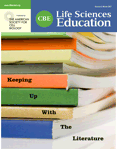Recent Research in Science Teaching and Learning
EDUCATION ARTICLES OF INTEREST
1. Anfara, V. A., Jr., Brown, K. M., and Mangione, T. L. (2002). Qualitative analysis on stage: making the research process more public. Educ. Researcher 31, 28–38. | |||||
Anfara and colleagues discuss some strategies that they have used, especially in working with education researchers-in-training, to assess and publicly disclose the “methodological rigor and analytical defensibility of qualitative research.”
2. Ercikan, K., and Roth, W.-M. (2006). What good is polarizing research into qualitative and quantitative? Educ. Researcher 35, 14–23. | |||||
Ercikan and Roth describe the epistemological continuum of education research, describing how different research questions and perspectives warrant the employment of different methodological and analytical approaches.
3. Scharfenberg, F.-J., Bogner, F. X., and Klautke, S. (2006). The suitability of external control-groups for empirical control purposes: a cautionary story in science education research. Elec. J. Sci. Educ. 11, 22–36. http://ejse.southwestern.edu/ (accessed 22 August 2007). | |||||
Scharfenberg and colleagues share findings related to the complex issue of identifying appropriate control groups for quasi-experimental studies. Specifically, their comparison of three instructional approaches yielded one “nontreatment” group that showed marked improvements in student achievement not observed in other nontreatment groups. The authors discuss possible causes of this anomaly and implications for study design.
LIFE SCIENCES EDUCATION ARTICLES OF INTEREST
1. Taraban, R., Box, C., Myers, R. Pollard, R., and Bowen, C. W. (2007). Effects of active-learning experiences on achievement, attitudes, and behaviors in high school biology. J. Res. Sci. Teach. 44, 960–979. | |||||
Taraban and colleagues study participation by high school students in microscopy and biotechnology lessons taught using laboratory (“active-learning”) versus lecture approaches. The authors share results related to their hypotheses that active learning produces measurable advantages over “traditional” teaching methods, including changes in students' knowledge and attitudes and teachers' behaviors.
2. Moni, R. W., Hryciw, D. H., Poronnik, P., and Moni, K. B. (2007). Using explicit teaching to improve how bioscience students write to the lay public. Adv. Physiol. Educ. 31, 167–175. http://advan.physiology.org/cgi/content/full/31/2/167 (accessed 19 September 2007). | |||||
Moni and colleagues use a pretest/posttest research design to study how explicit teaching of students to write in an opinion/editorial format improved their ability to write to a lay audience, including assessment of the students' writing by the target audience.
3. Duncan, R. G., and Reiser, B. J. (2007). Reasoning across ontologically distinct levels: students' understandings of molecular genetics. J. Res. Sci. Teach. 44, 938–959. | |||||
Duncan and Reiser explore students' difficulties with understanding molecular genetics and reasoning about genetic phenomena as interrelated physical and information-storing entities.



